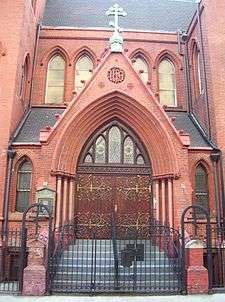American Carpatho-Russian Orthodox Diocese
The American Carpatho-Russian Orthodox Diocese of North America is a diocese of the Ecumenical Patriarchate with 78 parishes in the United States and Canada. Though the diocese is directly responsible to the Patriarchate, it is under the spiritual supervision of the Primate of the Greek Orthodox Archdiocese of America.
| This article forms part of the series | ||||
| Eastern Orthodox Christianity in North America | ||||
|---|---|---|---|---|
 | ||||
| History | ||||
| People | ||||
| Jurisdictions (list) | ||||
|
||||
| Monasteries | ||||
| List of monasteries in the United States | ||||
| Seminaries | ||||
| Organizations | ||||
|
||||
The diocese was led by Metropolitan Nicholas Smisko of Amissos (1936-2011). The current leader is the Metropolitan of Nyssa, Gregory Tatsis, who was consecrated on November 27, 2012.
History

At the end of the nineteenth century, many Ruthenians (Rusyns) immigrated to North America and established Eastern Catholic parishes. The Roman Catholic hierarchs, mostly Irish and Polish, however, belonged to the Latin Church and did not readily welcome the Ruthenians, fearing the "scandal" that the presence of married priests would have on their own flock.[2] Differences between the Eastern Catholics of the Byzantine Rite and the bishops of the predominant Latin Rite Catholics, especially regarding a married priesthood and the form of the Divine Liturgy or Mass, led some of them out of Roman Catholicism and into the Orthodox Church. A particularly strident opponent of non-Latin practices was John Ireland the Archbishop of St. Paul, Minnesota from 1888-1918, who refused to permit Ruthenian clergy to function in his archdiocese.[3]
The diocese was founded in 1938 when a group of 37 Ruthenian Eastern Catholic parishes, under the leadership of Fr. Orestes Chornock, were received into the jurisdiction of the Ecumenical Patriarchate. The year before, this group had officially renounced the Unia with the Holy See, primarily in protest over the Liturgical Latinisation occurring in their church life. A particularly divisive issue was the 1929 papal decree Cum data fuerit issued by Pope Pius XI which mandated that Eastern Rite clergy in the US were to be celibate.[4]
This move actually marked the second North American group of Ruthenian parishes to return to Orthodoxy. The first had been led by St. Alexis Toth of Wilkes-Barre into the jurisdiction of the Russian Metropolia in the 1890s. Notably, this second large-scale conversion to Orthodoxy by Carpatho-Russians was directed toward Constantinople rather than to the Russian presence in North America. This was primarily motivated out of concerns of Russification, which had occurred with the previous move. As such, rather than being absorbed into the body of Russian churches, and so being compelled to adopt Muscovite traditions, the ACROD was permitted by Constantinople to keep its distinctive Rusyn practices. Thus, the hymnography in the typical Ruthenian Prostopinije-chant[5] and liturgical forms, including the particular form of Old Church Slavonic used in the divine services, were preserved, while certain Latin Rite practices, such as the addition of the Filioque clause to the Nicene Creed, were removed.

Organization
In 2006, the ACROD had 14,372 members in 78 parishes and five missions.[6] Besides these, the ACROD operates Christ the Saviour Seminary in Johnstown, Pennsylvania. The bulk of the diocese's parishes are in 13 states in the eastern United States, with two parishes and two missions in Ontario; nearly half of the parishes are located in Pennsylvania.
There used to be two monasteries in the diocese: the Monastery of the Annunciation, in Tuxedo Park, New York which closed in the early 1990s and the Monastery of the Holy Cross, at Beallsville, Maryland which dissolved in the late 1990s when its abbot converted to Ruthenian (Byzantine Rite) Catholicism.[7]
The diocese is a member of Assembly of Canonical Orthodox Bishops of the United States of America.
Ruling Bishops
- Orestes (Chornock) of Agathonikeia (1938-1977)
- John (Martin) of Nyssa (1977-1984)
- Nicholas (Smisko) of Amissos (1985-2011)
- Gregory (Tatsis) of Nyssa (2012-Present)
References
- Dunlap, David W. (2004). From Abyssinian to Zion: A Guide to Manhattan's Houses of Worship. New York: Columbia University Press. ISBN 0-231-12543-7., p.234
- Barringer, Lawrence (1985). Good Victory. Brookline, Massachusetts: Holy Cross Orthodox Press. pp. 22–23. ISBN 0-917651-13-8.
- Tarasar, Constance, ed. (1975). Orthodox America: 1794-1976. Syosset, New York: Orthodox Church in America. pp. 50–51.
- Barringer. pp. 102–103
- American Carpatho-Russian Orthodox Diocese Prostopinije (Plain Chant Hymns)
- Data from the National Council of Churches' 2008 Yearbook of American & Canadian Churches
- http://omna.malf.net/hcnews.htm
External links
| Wikimedia Commons has media related to American Carpatho-Russian Orthodox Diocese. |
- Christ the Saviour Seminary
- Profile of the ACROD on the Association of Religion Data Archives website
- Article on ACROD by Ronald Roberson on the CNEWA website
- OrthodoxWiki:American Carpatho-Russian Orthodox Diocese, an OrthodoxWiki article
- A Detailed History of the American Carpatho-Russian Orthodox Diocese